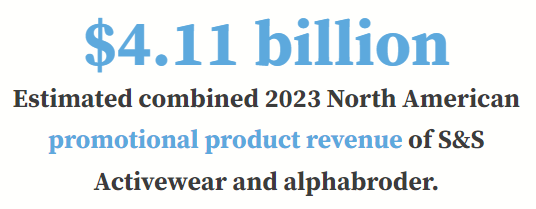Key Takeaways:
• Decoration in Flux for Joint S&S/alpha Venture: S&S plans to shutter the alphabroder apparel decoration operation by approximately the end of March. The firm would, if anything, look to offer decoration through a network of established screen printers and embroiderers.
• Hard Goods Strategy Revealed: S&S plans to continue offering hard goods, maintaining alphabroder’s hard goods offerings and later establishing a dedicated hard goods division.
• Pricing Stability: There are no plans to inflate prices post-acquisition, as S&S aims to support distributor profitability and customer growth in the promotional products market.
There was always going to be questions.
It’s natural, after all, that when a company executes the biggest acquisition in the history of an entire industry that professionals in the space are going to be awfully curious about what it all means and what comes next.
Frank Myers stepped into the center stage spotlight – literally – at the 2024 ASI Power Summit to answer some of those hot-topic questions that have feverishly circulated since the multibillion-dollar firm he helms, Counselor Top 40 supplier S&S Activewear (asi/84358), acquired fellow multibillion-dollar Top 40 supplier alphabroder (asi/34063).

Announced in August, the deal officially closed at the outset of October. It’s the latest part of a massive growth story for S&S as it’s evolved from a regional Midwest supplier. Myers has been at the company for the supplier’s biggest moves; with a background in investment banking and private equity, he joined the supplier in 2009 in a C-suite role (and was named CEO in 2022) and has been an integral driver of the company’s expansion strategy, which has included building distribution facilities at strategic locations throughout North America.
Armed with backing from a majority investment from private equity firm Clayton, Dubilier & Rice, S&S has made multiple acquisitions and, as Myers said, become technology-driven through numerous means, such as robot-driven automation that streamlines fulfillment.
Still, there are major questions about what the future holds for two of the biggest apparel suppliers, and Myers – who rose 20 spots on this year’s Counselor Power 50 list as a result of the alpha acquisition – answered them during his Q&A with ASI President & CEO Tim Andrews.
In-House Decoration
Myers explained that S&S’s business has traditionally been about 60% with apparel decorators, 40% with promo distributors. This caused ample concern among screen printers when S&S bought alphabroder since the latter has an in-house apparel decoration operation. Was S&S suddenly about to start competing with all its decorator customers?
Myers shot down that prospect, saying S&S plans to shutter the alphabroder apparel decoration operation by approximately the end of March. The firm would, if anything, look to offer decoration through a network of partners – already-established screen printers and embroiderers. “We would leverage the capacity that’s already out there,” said Myers. “We want to enable decorators to grow.”
Hard Goods
Back in 2017, alphabroder made a big acquisition of its own, expanding beyond its apparel business and acquiring hard goods supplier Prime Line – then a Counselor Top 40 supplier. Alphabroder ultimately integrated Prime, centralizing all apparel and hard good offerings in 2023 on one website and unifying the company identity under a single banner.
With S&S always focusing on just apparel, it led many to wonder whether the supplier would nix alpha’s hard goods business. To the contrary, Myers said. The firm may, in fact, look to make investments on the hard goods side of the business, enhancing its commercial strategy for those products.
Relatedly, S&S has said that hard goods decoration will remain an offering for the alphabroder brand, and customers can continue to access such products and services through their existing channels. Looking ahead, S&S plans to create a standalone hard goods decoration business division that will be led by a general manager and supported by a sales and service team.
Hard goods “are a meaningful revenue contributor,” Myers told Andrews. “It’s a market we like.”
Pricing
A concern among distributors is what the S&S/alpha deal means for their own profitability. With a big three of apparel suppliers – S&S, alphabroder and Counselor Top 40 supplier SanMar (asi/84863) – reduced to two, S&S could leverage its strengthened position to hike prices.
Myers said there are no plans to inflate pricing because it doesn’t make business sense. Distributors would have to then level up what they charge end-clients in order to ensure viable margins, a prospect that could discourage end-buyers, perhaps compelling some to avoid any investment in branded apparel.
“We don’t want to inhibit our customers’ ability to sell” through prohibitive pricing, Myers stated. “We’re focused on continuing to enable growth for our customers.”

Integration
Promo’s second-biggest supplier buying the market’s third-biggest supplier by revenue has implications for the entire industry. If things don’t go well, negative impacts could, some fear, ripple throughout the branded-merch marketplace.
While it’s only been two months since the acquisition was announced and less than two weeks since it closed, Myers said that so far the integration has gone well, with collaboration prevailing.
“Culture is a huge piece of bringing two businesses together, and we have more in common than we do apart,” he said. “We’re working to create the best business we can for our customers. It’s all about customer value proposition, figuring out how to build a better business than we could if we remained separate.” This effort includes learning what customers will need in the years ahead, and then constructing solutions that meet those needs.
Branding
In short, the jury is out on branding.
For now, the firms are going to market under their respective brand offerings backed by their existing distribution channels.
Myers said the company is currently engaged in brand equity research to determine important elements like just how each brand is perceived and where their deepest value lies, and he acknowledged both brands have standing in the marketplace. (He joked that his idea to call the combined company “Frank’s Apparel” was widely shot down.) With more information, leadership can then decide whether to carry forward with two brands or not. “It’s all,” said Myers, “about what makes the best sense for our customers.”



